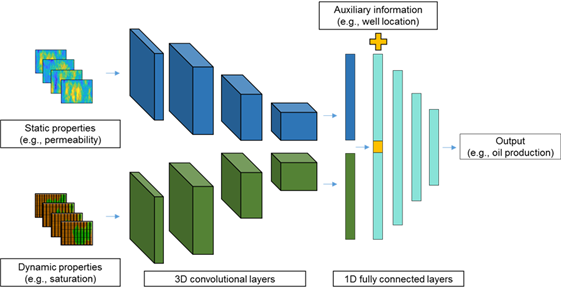3D arrays that consist of static and dynamic reservoir properties near an infill well (e.g., permeability and saturation) are input to the convolutional layer, which is the first layer of the CNN to extract features from the input arrays. Multi-modal learning is applied to the CNN for feature extraction of various types of input data. The features are obtained by repeating convolution and pooling processes, transformed as a 1D array, and delivered to a fully connected layer of the CNN. The fully connected layer also adds auxiliary 1D input array composed of spatial data such as distances between wells for improving the predictability of the CNN. The fully connected input layer is, via other fully connected layers called hidden layers, linked to the output layer that evaluates the productivity at each candidate infill well location. The proposed multi-modal CNN is designed using Keras, a deep learning library in Python environments. The performance of the CNN is tested with application to a benchmark oil reservoir model SPE10 and compared to the performance of a conventional neural network.
딥러닝 기반 프록시를 결합한 유·가스전 운영 최적화 프로그램의 개발
이 연구는 추가정의 최적 위치를 선정하는 과정에서 의사결정을 신속하게 진행하기 위하여 저류층 시뮬레이션 기반의 딥러닝 프록시 기법을 제안하였다. 기존의 인공신경망(artificial neural network)은 입력값의 공간적 분포를 무시하고 1차원 배열로 변환하여 학습하는 한계가 있었다. 합성곱 신경망(convolutional neural network)은 다차원 배열 형태의 입력값에서 공간적 분포 특징을 추출하는데 탁월하다. 합성곱 신경망을 사용하여 유정 인근의 물성 분포와 유정의 생산성 사이의 관계를 학습하고, 학습된 신경망 모델에 생산성이 학습되지 않은 좌표 주위의 물성 분포를 입력하면 해당 좌표에 추가정이 시추된 경우의 생산성을 예측할 수 있다. 이 연구에서는 정적 물성(예: 유체투과도)과 동적 물성(예: 오일 포화도)을 통합적으로 고려하기 위하여 다중모달 학습(multi-modal learning)을 합성곱 신경망에 적용하여 다양한 종류의 입력값을 분석할 수 있도록 하였다.

Figure. 추가 시추정 위치 최적화를 위한 다중모달 CNN의 구조도.
![]()
